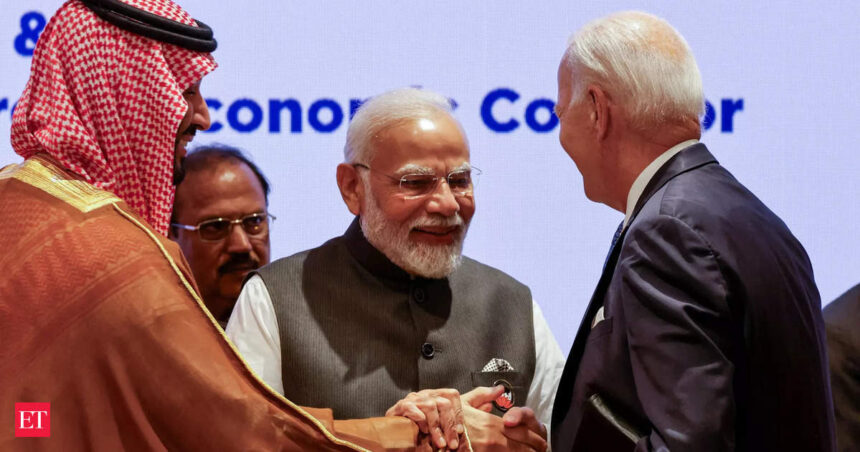The precise route map of the corridor will be figured out when the stakeholders meet in the next two months. But a Memorandum of Understanding (MoU) unveiled on the sidelines of the G20 leaders’ meeting shed light on its broader contours — a transit through India, the United Arab Emirates (UAE), Saudi Arabia, Jordan, Israel, and Europe. The proposal also includes a new railway line across the Arabian peninsula, with cables for electricity and digital connectivity and pipes for clean hydrogen running in parallel.
In essence, the project will have multiple components — an east corridor connecting India to the Arabian Gulf by sea, a northern corridor linking the Gulf to Europe, and deployment of rail and road linkages on its land section — a part-sea, part-land trade corridor with transshipment facilitation in between.
No doubt, the IMEC will help New Delhi leverage its economic and geopolitical potential. India’s G20 Sherpa, Amitabh Kant, tells ET that it will be like “a plug-and-play project”, with a significant potential to unlock massive trade opportunities that were missing because of connectivity issues.
“For example, the IMEC has the potential to reduce trade time between the EU and India by 40%, which will be a significant boost in reducing energy costs and increasing trade,” Kant says, adding that the corridor will act as a green and digital bridge, linking key commercial hubs, enabling production and export of clean energy, expanding power grids and telecommunication networks.
“This will be critical to boost India’s economic growth, while balancing its climate ambitions,” he says.Once the project is complete, Indian exporters to Europe will likely gain both in terms of time and cost.

Vinod Kaul, executive director of All India Rice Exporters Association, says that the overall cost of sending goods to Europe will likely drop. “At present, a consignment from Mundra (Gujarat) to Germany via sea takes about 25 days as against just 3-4 days to the UAE. Also, the freight cost for a 20 feet container to Germany is $1,500 whereas it is only $25 for the UAE. So, for the long-distance traffic in particular, this new corridor will be a game-changer even as the process will involve some amount of loading and unloading on the way (from ship to train and vice-versa),” he says.
Officially, the project has eight key stakeholders — India, the UAE, Saudi Arabia, Italy, France, Germany, the US and the European Union — the countries which were signatories of the MoU released during the G20. Even before the project gets off the ground, it has polarised global debates. Israel, for instance, seems to be over the moon despite not being an official partner (the MoU uses the word “participant” not partners or stakeholders) whereas Turkey, which has historically positioned itself as the bridge between Asia and Europe, has voiced its skepticism in public after getting cold shoulder from several G20 members.
Sample this: Israel’s prime minister Benjamin Netanyahu hailed the corridor as “a cooperation project that is the greatest in our history,” whereas his national security adviser Tzachi Hanegbi paints it as “the most meaningful evidence” of Saudi-Israeli ties advancing from “a shot in the dark” to a realistic opportunity with tangible goals, according to The Times of Israel dated September 13. Another report published by the Financial Times on September 17 quoted Turkey president Recep Tayyip Erdo an saying that “there can be no corridor without Turkey”, also adding that “the most appropriate route for trade from east to west must pass through Turkey”.
From India’s geopolitical perspective though, as experts argue, bypassing hostile Turkey and rolling out the red carpet to friendly Israel is the bestcase scenario, and it’s happening.
This isn’t the first time it’s happening — some 2,000 years ago, maritime trade between ancient India and the Roman empire took shape, a route which survived and flourished in the subsequent centuries. Discoveries of Roman coins across India’s west coast bear testimony to these ties. The question is — can the proposed IMEC be called an evocation of the past, rivalling the Silk Roads, a set of ancient trade routes that linked China to Europe and many parts of the world? “Most serious scholars would argue that maritime and land routes are not distinct but part of a single ecosystem of Silk Roads,” says Peter Frankopan, a professor of global history in Oxford University, in an email interview to ET.
“Trying to suggest they are alternatives is something that has in part sprung from China’s ‘Belt and Road Initiative’ – and the implication that there are two different sets of connections,” he says, also arguing that investments into IMEC will eventually benefit China and some other nations which are being left out in this new project.
There’s no doubt that the US is backing the project mainly to counter China’s growing clout over economically weaker nations, a blueprint where India’s size as well as its geographical location may pay dividends. Jayant Dasgupta, former ambassador of India to the World Trade Organization, argues that the corridor will hand India more geopolitical dividends than pure economic benefits. “Many countries are trapped by the Chinese BRI because of high interest rates and difficult repayment schedules. Yes, the IMEC is still a nebulous idea and its economics are being worked out, but it will definitely help India geopolitically,” he says, adding that the corridor could be structured as one big entity with each participating nation holding an equity in it.
Regarding the possible funding patterns of the corridor, G20 Sherpa Kant adds, “The IMEC being closely associated with PGII can potentially mobilise and attract significant parts of $600 billion pledged for PGII for critical infrastructure development.” PGII, or Partnership for Global Infrastructure and Investment, is a G7 initiative to fund infrastructure projects in developing nations.
Kant further says that the IMEC will be broken into commercially doable components, derisked with all approvals. “This will lead to the private sector getting attracted (to the project),” he adds.
This also means unlike BRI, the IMEC will bank on private sector participation, particularly in building core sector projects along the route. Vinayak Chatterjee, an infrastructure expert and managing trustee of The Infravision Foundation, says that India’s biggest opportunity in the corridor lies in building a dedicated rail line through the Arabian Peninsula — from Dubai to Haifa, a port in Israel — a long stretch through the desert with multiple missing rail links and no dedicated freight line at all. “India should compete to build new railway lines and also operate those. That will elevate our nation’s position in the global infra arena,” he says. shantanu.sharma@timesgroup.com







